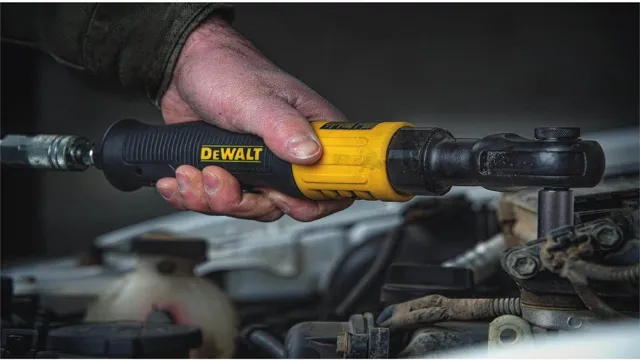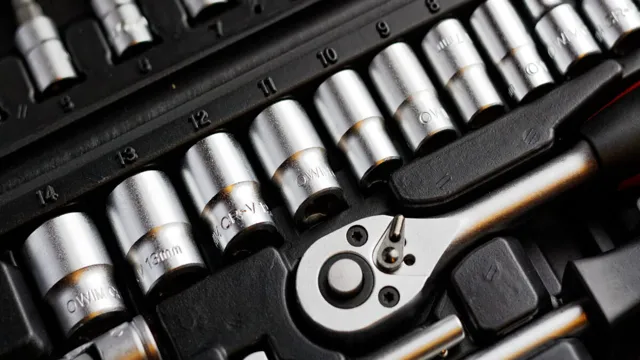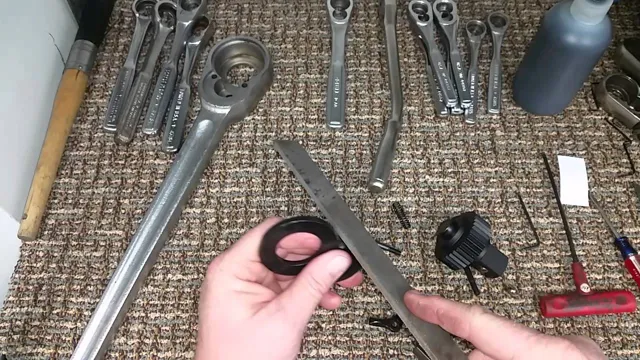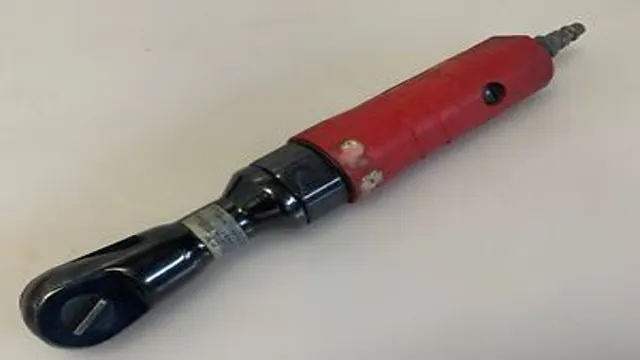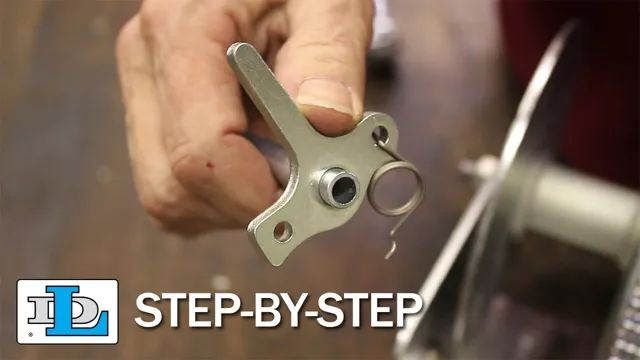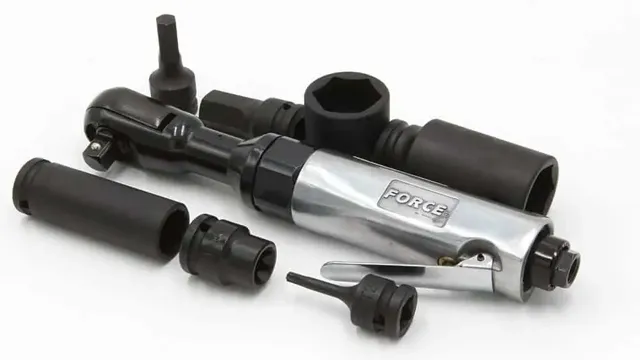What is an Air Ratchet? A Comprehensive Guide to Understanding Its Uses and Advantages
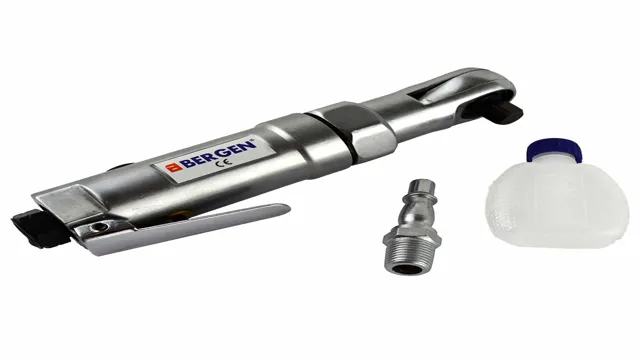
Air ratchets are an excellent tool that every DIY enthusiast and professional mechanic should add to their toolkit. But what exactly is an air ratchet? Simply put, it’s a versatile tool that uses compressed air to turn a socket. Think of it as a power tool that can help you remove or tighten nuts and bolts with ease.
It’s perfect for jobs that require you to get into tight spaces. If you’re tired of using a manual wrench or ratchet, an air ratchet is a game-changer. With the ability to rotate the socket faster than you can turn a wrench, you’ll save your hands and wrists from strain.
Plus, it’s much faster, which means you can get the job done more quickly. But don’t worry, you don’t need to be a seasoned mechanic to use an air ratchet. They’re simple to use, and once you get the hang of it, you’ll wonder why you waited so long to invest in one.
So if you have a project that requires a lot of bolts or nuts to tighten, an air ratchet is the perfect tool to make sure you get it done quickly and effortlessly.
Definition
An air ratchet is a compact and lightweight tool used for tightening and loosening bolts in hard-to-reach places. It’s a type of pneumatic wrench, meaning it uses air pressure to generate the torque required to turn bolts. An air ratchet typically has a ratcheting mechanism, making it easier to use than a traditional wrench because it doesn’t require users to reposition it for every turn.
Instead, an air ratchet turns the bolt in one direction and then automatically resets for the next turn. The size and shape of an air ratchet make it incredibly versatile and useful in many different settings, such as automotive and machinery repair. Overall, an air ratchet is an essential tool in any mechanic or DIY enthusiast’s arsenal.
Air Ratchet vs. Electric Ratchet
When it comes to choosing between an air ratchet and an electric ratchet, it can be confusing for those who are not familiar with the tools. An air ratchet, also known as a pneumatic ratchet, uses compressed air to turn the ratchet. On the other hand, an electric ratchet is powered by an electric motor.
Both tools have their own advantages and disadvantages. The main advantage of an air ratchet is that it is lighter and more flexible than an electric ratchet. It is also easier to maintain as it has fewer moving parts compared to an electric ratchet.
On the other hand, an electric ratchet is more powerful and can be used in places where there is no access to compressed air. It is also easier to control the speed and torque of an electric ratchet compared to an air ratchet. Ultimately, it depends on your needs and preferences.
If you need a lighter and more flexible tool, then an air ratchet might be the best choice for you. However, if you require more power and control, then an electric ratchet is the better option.

Benefits of Using an Air Ratchet
An air ratchet is a powerful tool that can make any mechanical job much easier and faster. It is typically a handheld device that uses compressed air to turn sockets and other attachments. The benefits of using an air ratchet are numerous.
First, it is much faster than using a traditional hand ratchet. This means you can get your work done more quickly and easily. Second, it is much more precise than using a hand ratchet.
You can easily control the speed and torque of the air ratchet, making it ideal for delicate jobs that require precision. Finally, using an air ratchet can save you a lot of physical strain. You won’t have to use as much force when turning bolts and other fasteners, which can save your hands and wrists from getting tired or injured.
Overall, if you are looking for a way to make your mechanical jobs easier and more efficient, investing in an air ratchet is definitely worth considering.
Speed and Efficiency
When it comes to mechanical work, speed and efficiency are key. That’s where using an air ratchet can come in handy. An air ratchet is a pneumatic tool that is designed to quickly and easily tighten and loosen bolts and nuts.
One of the biggest benefits of using an air ratchet is its speed. Unlike manual ratchets, which can be slow and laborious, air ratchets can save you time by helping you quickly get through a job. Another major plus is its efficiency, as an air ratchet can handle much more torque than a manual ratchet, making it easier to tackle difficult and stubborn bolts.
Additionally, because air ratchets are powered by compressed air, they are generally lighter and more compact than their manual counterparts, making them easier to maneuver in tight spaces. Overall, an air ratchet can be an invaluable tool for anyone who regularly works on cars or machinery.
Versatility and Convenience
Air Ratchet One of the biggest benefits of using an air ratchet is its versatility and convenience. Unlike a traditional ratchet, which requires manual effort to turn the socket, an air ratchet operates using compressed air. This means that you can use it for longer periods of time without experiencing hand fatigue or strain.
Additionally, air ratchets are convenient to use in tight spaces, making them particularly useful for automotive and mechanical work. Another advantage of air ratchets is their speed. They can quickly and easily remove nuts and bolts, saving you time and effort.
In general, an air ratchet is an essential tool for any DIY enthusiast or professional mechanic, thanks to its versatility and convenience. So, if you’re in the market for a new ratchet, consider making the switch to an air ratchet and enjoy these benefits for yourself!
Types of Air Ratchets
What is an air ratchet? An air ratchet is a pneumatic tool used for tightening or loosening nuts and bolts. It uses compressed air to rotate a certain part of the mechanism, usually the socket wrench, in a quick and efficient manner. There are two types of air ratchets: straight air ratchets and angled air ratchets.
Straight air ratchets have a straight body, making it easier to access tight spaces, while angled air ratchets have a body that is set at a 90-degree angle, providing better torque. There are also reversible air ratchets, allowing you to switch the ratcheting direction with ease. Additionally, air ratchets come in varying sizes to handle different types and sizes of fasteners.
Before using an air ratchet, it’s important to make sure you have the correct socket size and torque settings. These powerful tools are commonly used in automotive and industrial settings, but can also be handy for DIY projects.
Pneumatic Air Ratchet
When it comes to power tools in the workshop, air ratchets are a must-have for any DIY enthusiast or professional mechanic. Pneumatic air ratchets are versatile and easy to use, but with so many different types available, it can be challenging to know which one to choose. One of the most common types of air ratchet is the pistol grip, which is user-friendly and allows for easy access to tight spaces.
Another type is the inline air ratchet, which is perfect for working in confined areas where pistol grip ratchets might be difficult to maneuver. For heavy-duty applications, there are also industrial air ratchets that offer exceptional power and torque, making them ideal for professional mechanics. Whatever your needs, it’s important to select the right type of air ratchet for your project to ensure maximum efficiency and performance.
With so many options available, you’re sure to find the perfect air ratchet for your workshop needs.
Electric Air Ratchet
When it comes to air ratchets, there are a few different types to choose from. One popular option is the electric air ratchet. These ratchets use electricity to power the tool, which means you don’t need to worry about replacing batteries or running out of power mid-job.
Electric air ratchets are also generally quieter than other types, making it easier to work in tight spaces without disturbing others. Another type of air ratchet is the pneumatic ratchet. These ratchets use compressed air to power the tool, which means they can be more powerful than electric models.
However, they can also be louder and more cumbersome to use. Ultimately, the type of air ratchet you choose will depend on your specific needs and preferences. If you want a quiet, easy-to-use tool for smaller jobs, an electric air ratchet may be the way to go.
If you need a more powerful tool for larger tasks, a pneumatic ratchet may be the better choice. Regardless of which type you choose, be sure to select a high-quality tool from a reputable manufacturer to ensure optimal performance and longevity.
How to Use an Air Ratchet
An air ratchet is a type of tool powered by compressed air that allows you to tighten or loosen bolts quickly and easily. It functions similarly to a traditional ratchet, but with the added benefit of using air power to make the job faster and more efficient. To use an air ratchet, you’ll need an air compressor to power the tool.
Simply attach the appropriate size socket to the ratchet head, and then place the socket over the bolt you need to tighten or loosen. Engage the ratchet mechanism in the direction you need to turn the bolt, and the air pressure will do the work for you. Air ratchets are commonly used in automotive repair shops, but they can also be used for a wide range of other tasks.
With a little practice, you’ll find that an air ratchet can be an invaluable addition to your tool collection.
Step-by-Step Instructions
Air ratchets are a handy tool for any mechanic or DIY enthusiast who wants to get the job done quickly and efficiently. If you’re new to using air ratchets, don’t worry, it’s pretty simple. First, attach a compatible socket to the air ratchet.
Then, plug the tool into an air compressor, making sure to connect the hose to both the air ratchet and the compressor. Once everything is connected, turn on the air compressor and adjust the pressure, so it matches the manufacturer’s recommended settings for the tool. Finally, hold the air ratchet and use it to turn the bolts or nuts in whichever direction you need.
The best thing about these tools is that they make the process so much quicker, with little effort from the user. It’s like having an extra hand when you need it the most!
Conclusion
In short, an air ratchet is like Batman’s utility belt – it’s the trusty tool that can save the day in tight spaces and tricky situations. A prolific power tool in the automotive industry, an air ratchet is a marvel of compact design and efficient performance, making it the go-to choice for mechanics and DIY enthusiasts alike. From loosening stubborn nuts to tightening bolts with ease, an air ratchet is the true hero of the garage.
So, whether you’re a professional mechanic or a weekend warrior, investing in an air ratchet is as essential as having a cape for a superhero!”
FAQs
What is an air ratchet and how does it work?
An air ratchet is a type of power tool that uses compressed air to rotate the ratchet mechanism, providing torque to loosen or tighten bolts and nuts. The air-powered tool works by delivering a steady stream of compressed air to the tool’s motor, which generates the rotation needed to turn fasteners.
What are the advantages of using an air ratchet over a manual ratchet?
The biggest advantage of using an air ratchet is the speed and ease of use it provides. With an air-powered tool, you can quickly and effortlessly remove or install bolts and nuts, saving time and effort. Air ratchets are also lightweight, portable, and have a longer lifespan than manual ratchets.
What kind of maintenance does an air ratchet require?
Air ratchets require regular maintenance to keep them in good working condition. This includes regular lubrication of all moving parts with a high-quality air tool oil and regular cleaning to remove any debris or dust buildup. It’s also important to regularly check the tool’s air hose and fittings for any signs of damage or wear.
Can an air ratchet be used on any type of fastener?
An air ratchet can be used on most types of fasteners, including bolts, nuts, and screws. However, it’s important to choose the right size and type of socket to ensure the best fit and avoid any damage to the fastener or the tool.
How much air pressure is needed to operate an air ratchet?
The amount of air pressure needed to operate an air ratchet can vary depending on the tool’s size and design. In general, most air ratchets require an air pressure of at least 90 psi to operate effectively.
What safety precautions should be taken when using an air ratchet?
When using an air ratchet, it’s important to wear appropriate safety gear, including eye protection and hearing protection. Always follow the manufacturer’s instructions and maintain a firm grip on the tool to prevent it from slipping or flying out of your hand. Never use the tool in areas with flammable gases or liquids, and always disconnect the tool from the air supply before making any adjustments or repairs.
Can an air ratchet be used in tight spaces?
Yes, one of the advantages of an air ratchet is its compact size, which makes it ideal for use in tight spaces where a manual ratchet might not fit. However, it’s important to choose the right socket size and type to ensure the tool can be properly positioned and used safely.

